NRS-429VN: Learning Styles and VARK Analysis Report - Analysis
VerifiedAdded on 2022/11/30
|5
|1218
|178
Report
AI Summary
This report presents an analysis of the VARK questionnaire results, which assesses individual learning preferences across visual, aural, read/write, and kinesthetic modalities. The author's VARK results are detailed, highlighting a preference for read/write and visual learning styles. The report then discusses the impact of these preferred learning styles on academic performance, emphasizing the importance of reinforcing these modes for enhanced learning outcomes. Furthermore, the report compares the current learning style with the VARK results, finding alignment, and offering practical strategies for incorporating these preferences into study habits. The role of learning styles in educational activities and health promotion is also explored, underlining the significance of understanding individual learning preferences for optimizing both academic and health-related outcomes. The report concludes by referencing relevant literature to support the findings and recommendations.
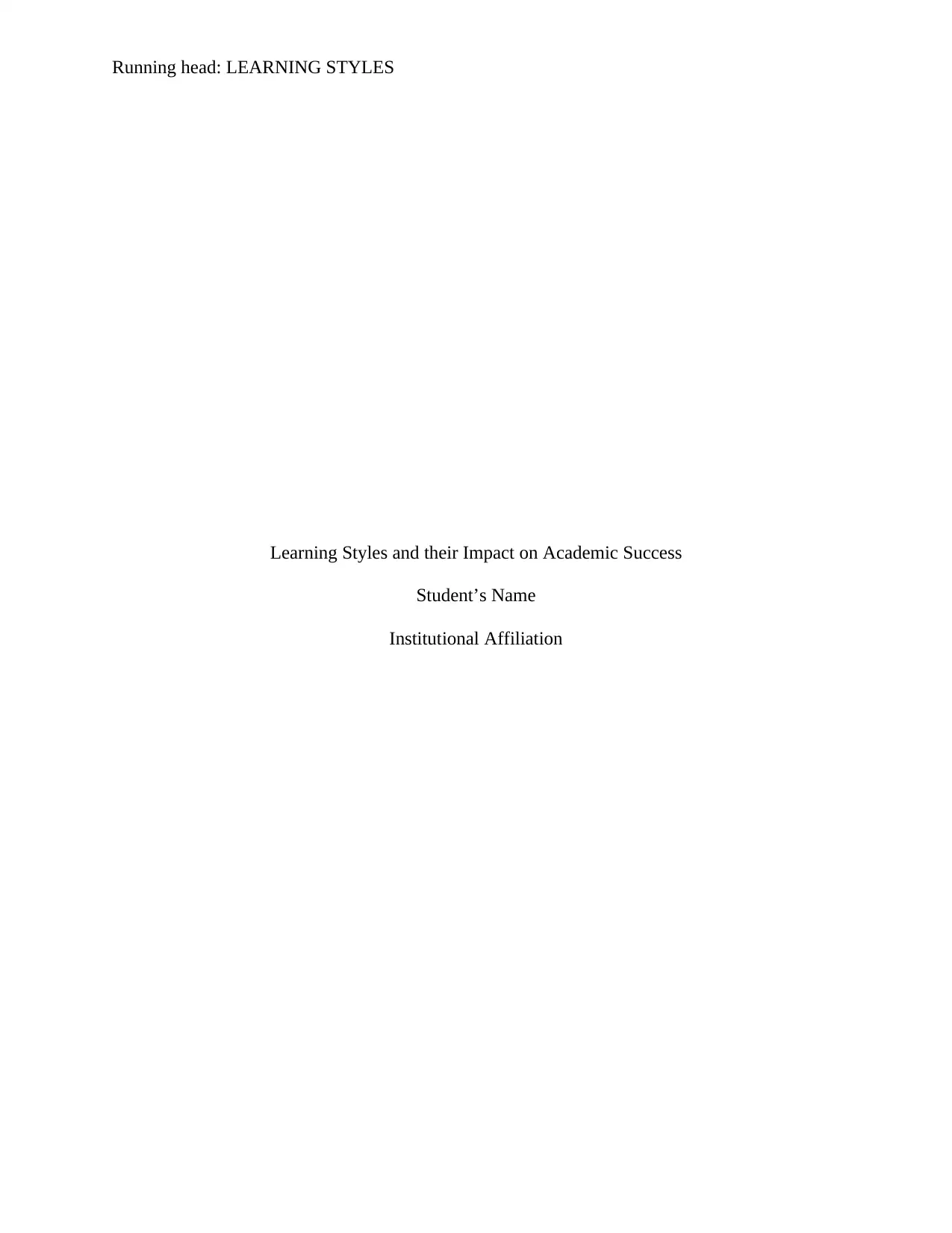
Running head: LEARNING STYLES
Learning Styles and their Impact on Academic Success
Student’s Name
Institutional Affiliation
Learning Styles and their Impact on Academic Success
Student’s Name
Institutional Affiliation
Paraphrase This Document
Need a fresh take? Get an instant paraphrase of this document with our AI Paraphraser
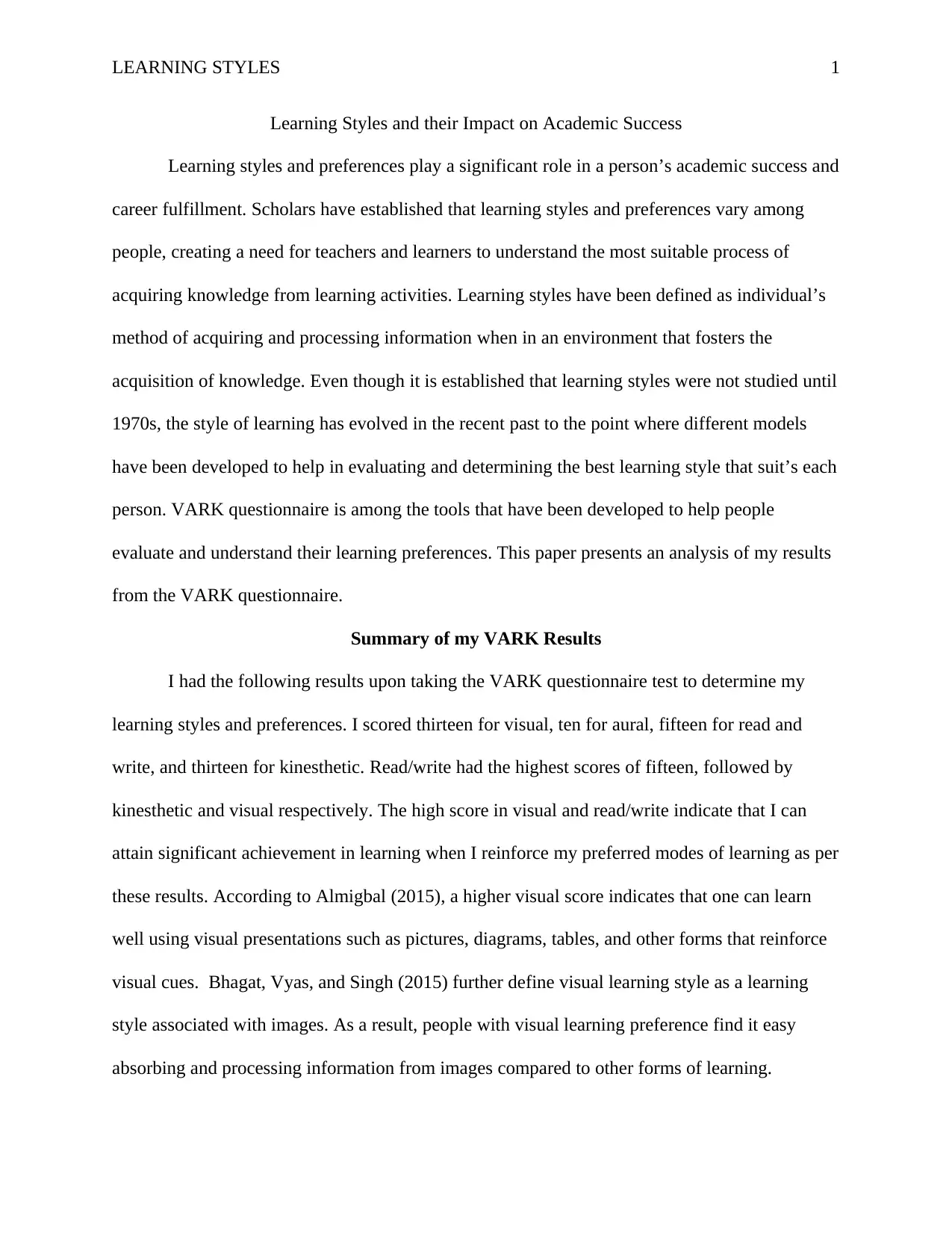
LEARNING STYLES 1
Learning Styles and their Impact on Academic Success
Learning styles and preferences play a significant role in a person’s academic success and
career fulfillment. Scholars have established that learning styles and preferences vary among
people, creating a need for teachers and learners to understand the most suitable process of
acquiring knowledge from learning activities. Learning styles have been defined as individual’s
method of acquiring and processing information when in an environment that fosters the
acquisition of knowledge. Even though it is established that learning styles were not studied until
1970s, the style of learning has evolved in the recent past to the point where different models
have been developed to help in evaluating and determining the best learning style that suit’s each
person. VARK questionnaire is among the tools that have been developed to help people
evaluate and understand their learning preferences. This paper presents an analysis of my results
from the VARK questionnaire.
Summary of my VARK Results
I had the following results upon taking the VARK questionnaire test to determine my
learning styles and preferences. I scored thirteen for visual, ten for aural, fifteen for read and
write, and thirteen for kinesthetic. Read/write had the highest scores of fifteen, followed by
kinesthetic and visual respectively. The high score in visual and read/write indicate that I can
attain significant achievement in learning when I reinforce my preferred modes of learning as per
these results. According to Almigbal (2015), a higher visual score indicates that one can learn
well using visual presentations such as pictures, diagrams, tables, and other forms that reinforce
visual cues. Bhagat, Vyas, and Singh (2015) further define visual learning style as a learning
style associated with images. As a result, people with visual learning preference find it easy
absorbing and processing information from images compared to other forms of learning.
Learning Styles and their Impact on Academic Success
Learning styles and preferences play a significant role in a person’s academic success and
career fulfillment. Scholars have established that learning styles and preferences vary among
people, creating a need for teachers and learners to understand the most suitable process of
acquiring knowledge from learning activities. Learning styles have been defined as individual’s
method of acquiring and processing information when in an environment that fosters the
acquisition of knowledge. Even though it is established that learning styles were not studied until
1970s, the style of learning has evolved in the recent past to the point where different models
have been developed to help in evaluating and determining the best learning style that suit’s each
person. VARK questionnaire is among the tools that have been developed to help people
evaluate and understand their learning preferences. This paper presents an analysis of my results
from the VARK questionnaire.
Summary of my VARK Results
I had the following results upon taking the VARK questionnaire test to determine my
learning styles and preferences. I scored thirteen for visual, ten for aural, fifteen for read and
write, and thirteen for kinesthetic. Read/write had the highest scores of fifteen, followed by
kinesthetic and visual respectively. The high score in visual and read/write indicate that I can
attain significant achievement in learning when I reinforce my preferred modes of learning as per
these results. According to Almigbal (2015), a higher visual score indicates that one can learn
well using visual presentations such as pictures, diagrams, tables, and other forms that reinforce
visual cues. Bhagat, Vyas, and Singh (2015) further define visual learning style as a learning
style associated with images. As a result, people with visual learning preference find it easy
absorbing and processing information from images compared to other forms of learning.
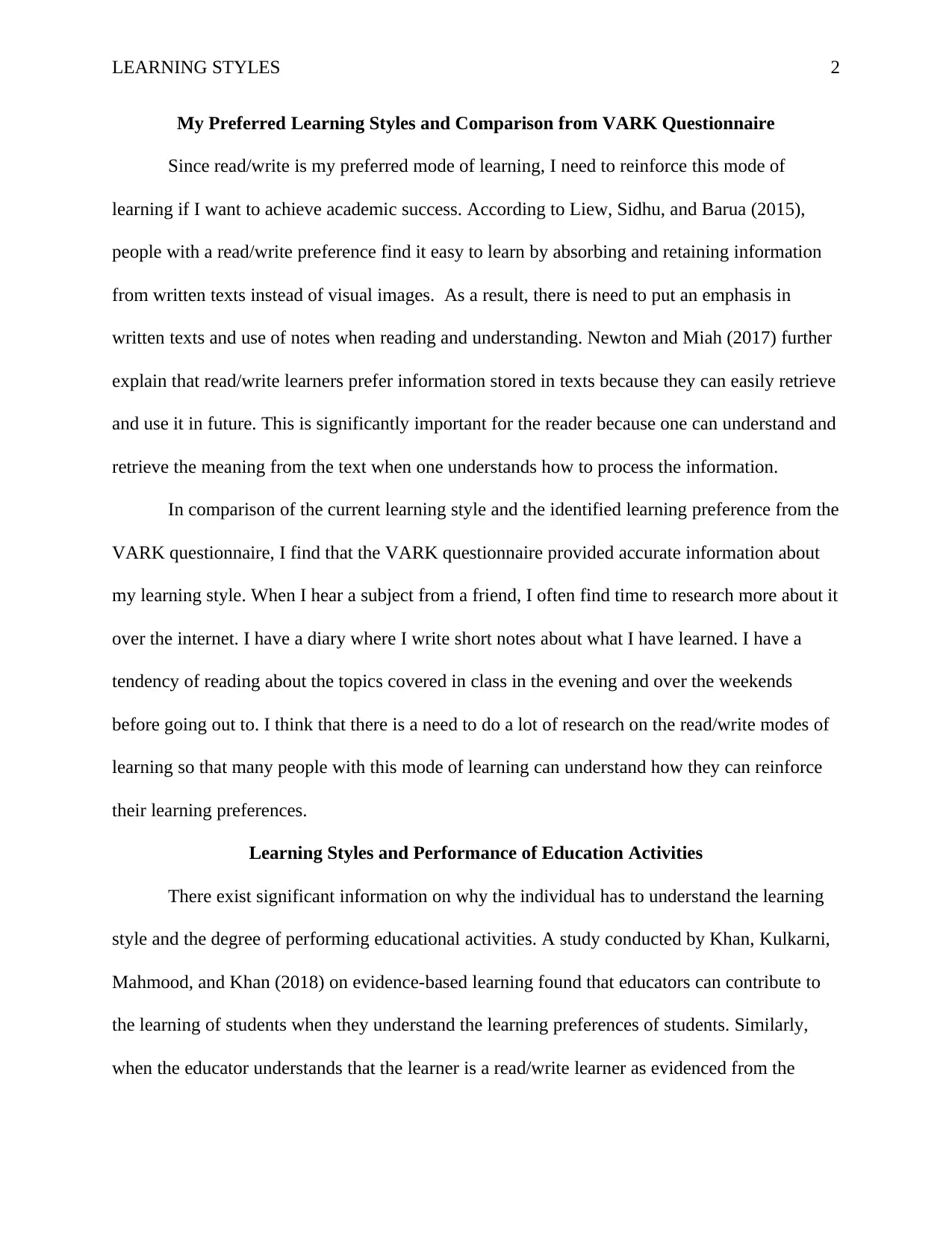
LEARNING STYLES 2
My Preferred Learning Styles and Comparison from VARK Questionnaire
Since read/write is my preferred mode of learning, I need to reinforce this mode of
learning if I want to achieve academic success. According to Liew, Sidhu, and Barua (2015),
people with a read/write preference find it easy to learn by absorbing and retaining information
from written texts instead of visual images. As a result, there is need to put an emphasis in
written texts and use of notes when reading and understanding. Newton and Miah (2017) further
explain that read/write learners prefer information stored in texts because they can easily retrieve
and use it in future. This is significantly important for the reader because one can understand and
retrieve the meaning from the text when one understands how to process the information.
In comparison of the current learning style and the identified learning preference from the
VARK questionnaire, I find that the VARK questionnaire provided accurate information about
my learning style. When I hear a subject from a friend, I often find time to research more about it
over the internet. I have a diary where I write short notes about what I have learned. I have a
tendency of reading about the topics covered in class in the evening and over the weekends
before going out to. I think that there is a need to do a lot of research on the read/write modes of
learning so that many people with this mode of learning can understand how they can reinforce
their learning preferences.
Learning Styles and Performance of Education Activities
There exist significant information on why the individual has to understand the learning
style and the degree of performing educational activities. A study conducted by Khan, Kulkarni,
Mahmood, and Khan (2018) on evidence-based learning found that educators can contribute to
the learning of students when they understand the learning preferences of students. Similarly,
when the educator understands that the learner is a read/write learner as evidenced from the
My Preferred Learning Styles and Comparison from VARK Questionnaire
Since read/write is my preferred mode of learning, I need to reinforce this mode of
learning if I want to achieve academic success. According to Liew, Sidhu, and Barua (2015),
people with a read/write preference find it easy to learn by absorbing and retaining information
from written texts instead of visual images. As a result, there is need to put an emphasis in
written texts and use of notes when reading and understanding. Newton and Miah (2017) further
explain that read/write learners prefer information stored in texts because they can easily retrieve
and use it in future. This is significantly important for the reader because one can understand and
retrieve the meaning from the text when one understands how to process the information.
In comparison of the current learning style and the identified learning preference from the
VARK questionnaire, I find that the VARK questionnaire provided accurate information about
my learning style. When I hear a subject from a friend, I often find time to research more about it
over the internet. I have a diary where I write short notes about what I have learned. I have a
tendency of reading about the topics covered in class in the evening and over the weekends
before going out to. I think that there is a need to do a lot of research on the read/write modes of
learning so that many people with this mode of learning can understand how they can reinforce
their learning preferences.
Learning Styles and Performance of Education Activities
There exist significant information on why the individual has to understand the learning
style and the degree of performing educational activities. A study conducted by Khan, Kulkarni,
Mahmood, and Khan (2018) on evidence-based learning found that educators can contribute to
the learning of students when they understand the learning preferences of students. Similarly,
when the educator understands that the learner is a read/write learner as evidenced from the
⊘ This is a preview!⊘
Do you want full access?
Subscribe today to unlock all pages.

Trusted by 1+ million students worldwide
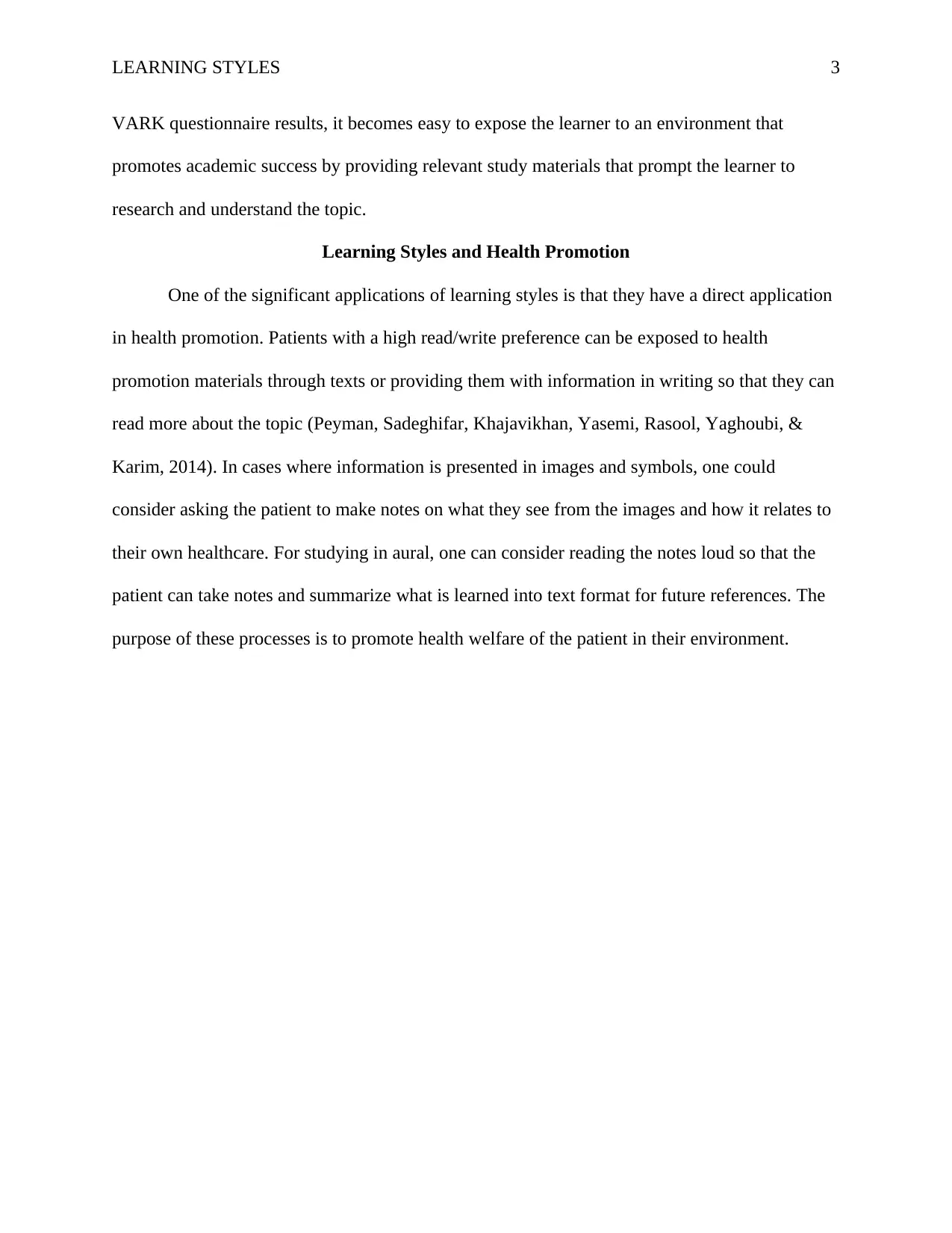
LEARNING STYLES 3
VARK questionnaire results, it becomes easy to expose the learner to an environment that
promotes academic success by providing relevant study materials that prompt the learner to
research and understand the topic.
Learning Styles and Health Promotion
One of the significant applications of learning styles is that they have a direct application
in health promotion. Patients with a high read/write preference can be exposed to health
promotion materials through texts or providing them with information in writing so that they can
read more about the topic (Peyman, Sadeghifar, Khajavikhan, Yasemi, Rasool, Yaghoubi, &
Karim, 2014). In cases where information is presented in images and symbols, one could
consider asking the patient to make notes on what they see from the images and how it relates to
their own healthcare. For studying in aural, one can consider reading the notes loud so that the
patient can take notes and summarize what is learned into text format for future references. The
purpose of these processes is to promote health welfare of the patient in their environment.
VARK questionnaire results, it becomes easy to expose the learner to an environment that
promotes academic success by providing relevant study materials that prompt the learner to
research and understand the topic.
Learning Styles and Health Promotion
One of the significant applications of learning styles is that they have a direct application
in health promotion. Patients with a high read/write preference can be exposed to health
promotion materials through texts or providing them with information in writing so that they can
read more about the topic (Peyman, Sadeghifar, Khajavikhan, Yasemi, Rasool, Yaghoubi, &
Karim, 2014). In cases where information is presented in images and symbols, one could
consider asking the patient to make notes on what they see from the images and how it relates to
their own healthcare. For studying in aural, one can consider reading the notes loud so that the
patient can take notes and summarize what is learned into text format for future references. The
purpose of these processes is to promote health welfare of the patient in their environment.
Paraphrase This Document
Need a fresh take? Get an instant paraphrase of this document with our AI Paraphraser
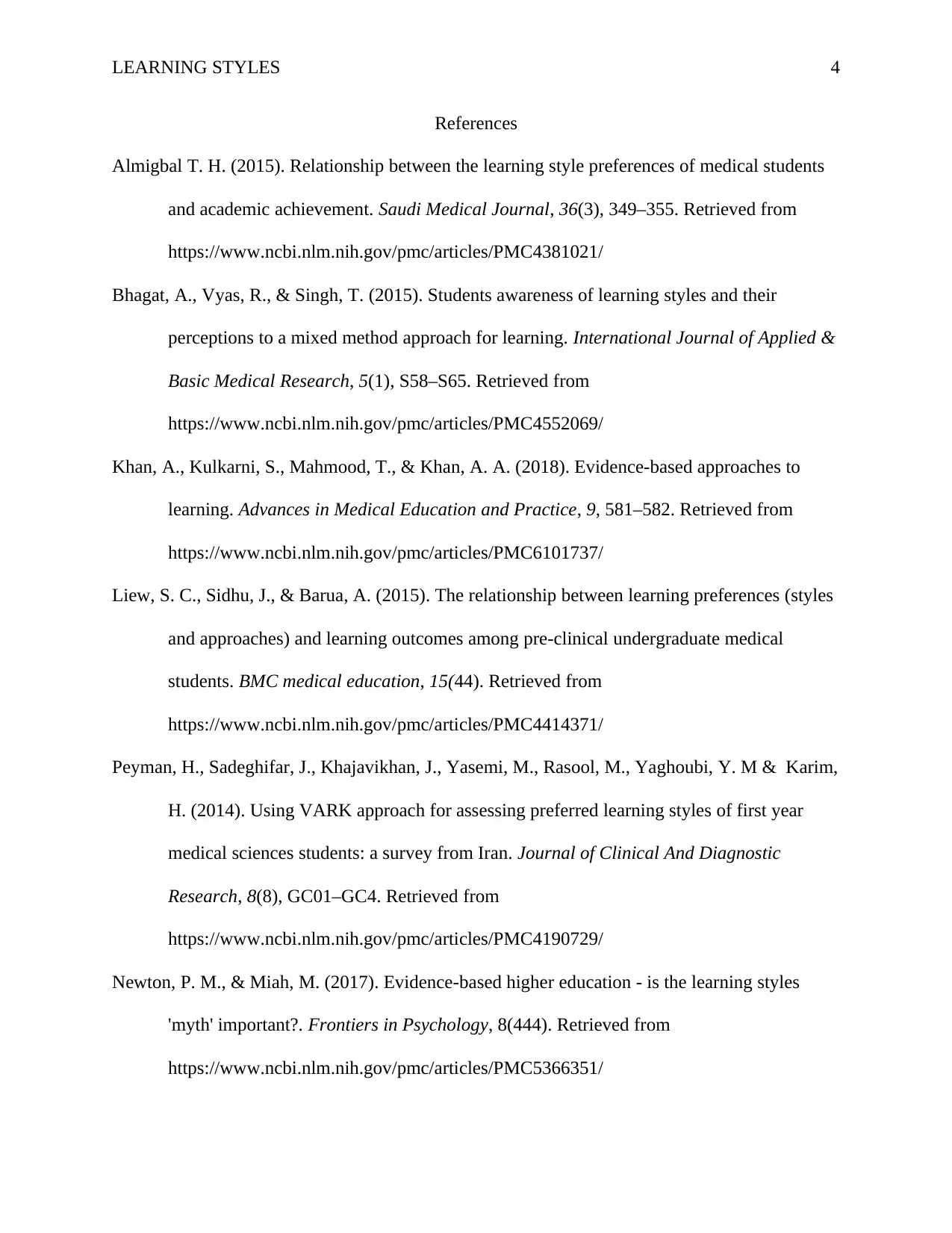
LEARNING STYLES 4
References
Almigbal T. H. (2015). Relationship between the learning style preferences of medical students
and academic achievement. Saudi Medical Journal, 36(3), 349–355. Retrieved from
https://www.ncbi.nlm.nih.gov/pmc/articles/PMC4381021/
Bhagat, A., Vyas, R., & Singh, T. (2015). Students awareness of learning styles and their
perceptions to a mixed method approach for learning. International Journal of Applied &
Basic Medical Research, 5(1), S58–S65. Retrieved from
https://www.ncbi.nlm.nih.gov/pmc/articles/PMC4552069/
Khan, A., Kulkarni, S., Mahmood, T., & Khan, A. A. (2018). Evidence-based approaches to
learning. Advances in Medical Education and Practice, 9, 581–582. Retrieved from
https://www.ncbi.nlm.nih.gov/pmc/articles/PMC6101737/
Liew, S. C., Sidhu, J., & Barua, A. (2015). The relationship between learning preferences (styles
and approaches) and learning outcomes among pre-clinical undergraduate medical
students. BMC medical education, 15(44). Retrieved from
https://www.ncbi.nlm.nih.gov/pmc/articles/PMC4414371/
Peyman, H., Sadeghifar, J., Khajavikhan, J., Yasemi, M., Rasool, M., Yaghoubi, Y. M & Karim,
H. (2014). Using VARK approach for assessing preferred learning styles of first year
medical sciences students: a survey from Iran. Journal of Clinical And Diagnostic
Research, 8(8), GC01–GC4. Retrieved from
https://www.ncbi.nlm.nih.gov/pmc/articles/PMC4190729/
Newton, P. M., & Miah, M. (2017). Evidence-based higher education - is the learning styles
'myth' important?. Frontiers in Psychology, 8(444). Retrieved from
https://www.ncbi.nlm.nih.gov/pmc/articles/PMC5366351/
References
Almigbal T. H. (2015). Relationship between the learning style preferences of medical students
and academic achievement. Saudi Medical Journal, 36(3), 349–355. Retrieved from
https://www.ncbi.nlm.nih.gov/pmc/articles/PMC4381021/
Bhagat, A., Vyas, R., & Singh, T. (2015). Students awareness of learning styles and their
perceptions to a mixed method approach for learning. International Journal of Applied &
Basic Medical Research, 5(1), S58–S65. Retrieved from
https://www.ncbi.nlm.nih.gov/pmc/articles/PMC4552069/
Khan, A., Kulkarni, S., Mahmood, T., & Khan, A. A. (2018). Evidence-based approaches to
learning. Advances in Medical Education and Practice, 9, 581–582. Retrieved from
https://www.ncbi.nlm.nih.gov/pmc/articles/PMC6101737/
Liew, S. C., Sidhu, J., & Barua, A. (2015). The relationship between learning preferences (styles
and approaches) and learning outcomes among pre-clinical undergraduate medical
students. BMC medical education, 15(44). Retrieved from
https://www.ncbi.nlm.nih.gov/pmc/articles/PMC4414371/
Peyman, H., Sadeghifar, J., Khajavikhan, J., Yasemi, M., Rasool, M., Yaghoubi, Y. M & Karim,
H. (2014). Using VARK approach for assessing preferred learning styles of first year
medical sciences students: a survey from Iran. Journal of Clinical And Diagnostic
Research, 8(8), GC01–GC4. Retrieved from
https://www.ncbi.nlm.nih.gov/pmc/articles/PMC4190729/
Newton, P. M., & Miah, M. (2017). Evidence-based higher education - is the learning styles
'myth' important?. Frontiers in Psychology, 8(444). Retrieved from
https://www.ncbi.nlm.nih.gov/pmc/articles/PMC5366351/
1 out of 5
Related Documents
Your All-in-One AI-Powered Toolkit for Academic Success.
+13062052269
info@desklib.com
Available 24*7 on WhatsApp / Email
![[object Object]](/_next/static/media/star-bottom.7253800d.svg)
Unlock your academic potential
Copyright © 2020–2025 A2Z Services. All Rights Reserved. Developed and managed by ZUCOL.





